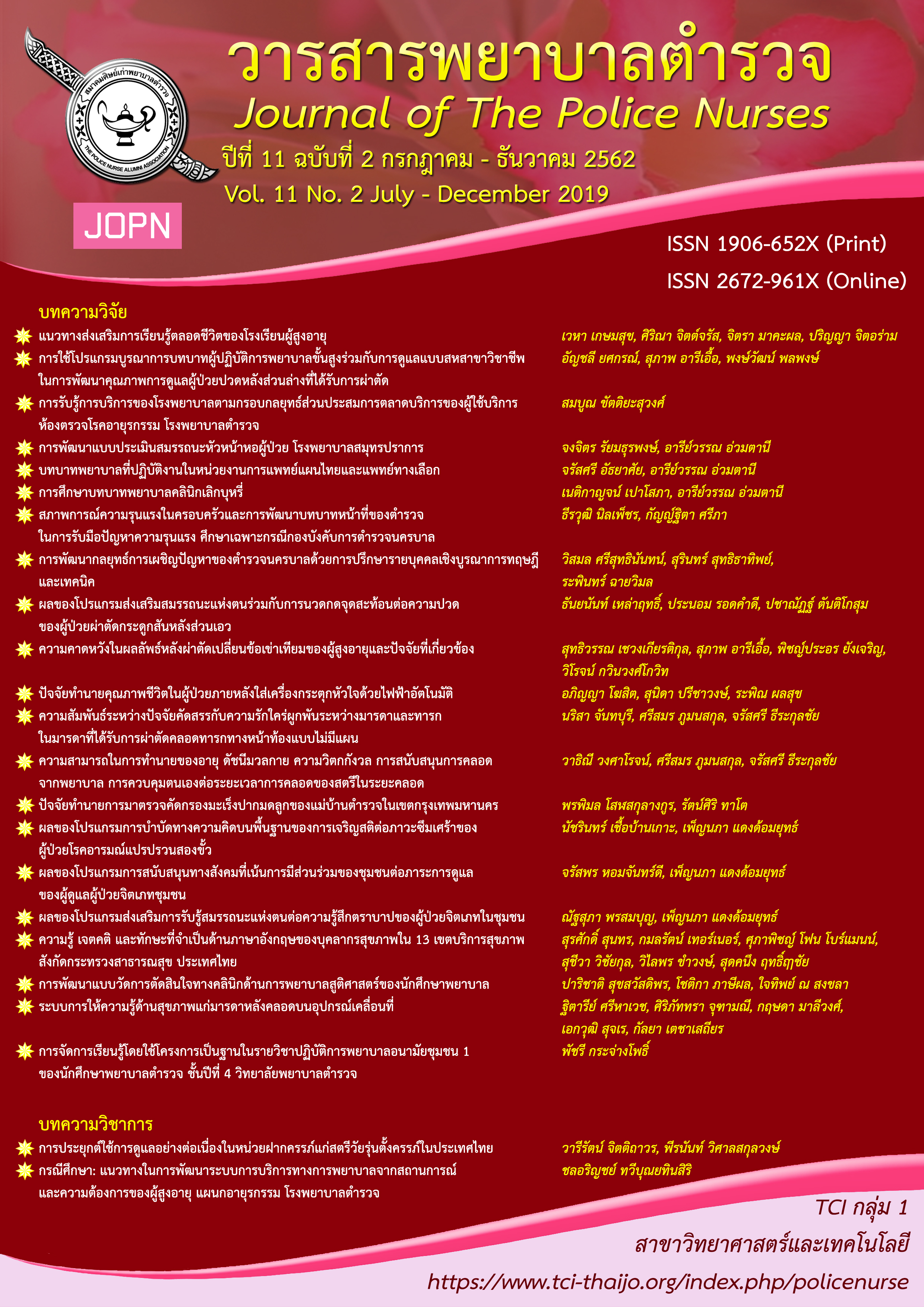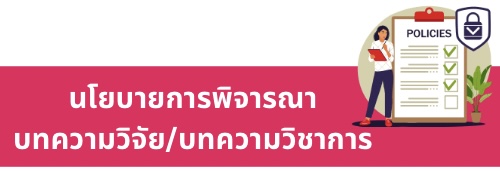ความคาดหวังในผลลัพธ์หลังผ่าตัดเปลี่ยนข้อเข่าเทียมของผู้สูงอายุและปัจจัยที่เกี่ยวข้อง
คำสำคัญ:
ความคาดหวังในการทำกิจกรรม, ผู้สูงอายุ, ก่อนผ่าตัดเปลี่ยนข้อเข่าเทียมบทคัดย่อ
การวิจัยครั้งนี้เป็นการวิจัยเชิงพรรณนาหาความสัมพันธ์ มีวัตถุประสงค์เพื่อศึกษาความคาดหวังในผลลัพธ์หลังผ่าตัดเปลี่ยนข้อเข่าเทียมของผู้สูงอายุและปัจจัยที่เกี่ยวข้อง ตัวอย่างเป็นผู้สูงอายุที่มีอายุตั้งแต่ 60 ปีขึ้นไปจำนวน 84 คน ที่ได้รับการวินิจฉัยเป็นโรคข้อเข่าเสื่อมและกำลังเข้ารับการรักษาด้วยการผ่าตัดเปลี่ยนข้อเข่าเทียมที่โรงพยาบาลสังกัดมหาวิทยาลัยแห่งหนึ่งในกรุงเทพมหานคร เครื่องมือที่ใช้คือ แบบบันทึกข้อมูลส่วนบุคคล แบบประเมินข้อเข่าด้านการเคลื่อนไหวในกิจวัตรประจำวัน และแบบสอบถามความคาดหวังในผลลัพธ์จากการผ่าตัดเปลี่ยนข้อเข่าเทียม เก็บรวบรวมข้อมูลด้วยวิธีการสัมภาษณ์และทำการวิเคราะห์ข้อมูลโดยใช้สถิติบรรยาย สถิติอ้างอิงโดยเปรียบเทียบค่าเฉลี่ยระหว่างตัวอย่างสองกลุ่มที่เป็นอิสระจากกัน และสัมประสิทธิ์สหสัมพันธ์แบบเพียร์สัน
ผลการวิจัยพบว่า ความคาดหวังในผลลัพธ์หลังผ่าตัดเปลี่ยนข้อเข่าเทียมของผู้สูงอายุเฉลี่ยโดยรวมอยู่ในระดับสูง (M= 69.41, SD=13.87) เมื่อพิจารณารายข้อพบว่าตัวอย่างมีความคาดหวังว่า “การผ่าตัดเปลี่ยนข้อเข่าเทียมจะเพิ่มความสามารถในการเดินในระยะสั้น” สูงที่สุด (M=3.69, SD=.51) รองลงมาคือ “มีสุขภาวะทางจิตที่ดีขึ้น” (M=3.63, SD=.62) ส่วนความคาดหวังที่น้อยที่สุดคือ “การมีความสามารถในการมีกิจกรรมทางเพศที่เพิ่มขึ้น” (M=.55, SD=1.17) และ “การยังคงถูกจ้างงานและได้รับเงินชดเชย” (M=.68, SD=1.38) ผู้สูงอายุที่มีเพศและความสามารถในการทำกิจกรรมต่างกัน มีความคาดหวังในผลลัพธ์หลังผ่าตัดเปลี่ยนข้อเข่าเทียมแตกต่างกันอย่างมีนัยสำคัญทางสถิติ (t=3.363, p=.001 และ t=3.911, p=.000 ตามลำดับ) และยังพบว่า เพศและความสามารถในการทำกิจกรรมก่อนผ่าตัด มีความสัมพันธ์กับความคาดหวังในผลลัพธ์หลังผ่าตัดเปลี่ยนข้อเข่าเทียมอย่างมีนัยสำคัญทางสถิติ (r=-.348, p=.001 และ r=.382, p=.000 ตามลำดับ) ผลการศึกษาครั้งนี้ช่วยให้ทีมสุขภาพเข้าใจความคาดหวังในผลลัพธ์หลังผ่าตัดเปลี่ยนข้อเข่าเทียมของผู้สูงอายุ ซึ่งข้อมูลดังกล่าวเป็นพื้นฐานสำคัญในการนำไปวางแผนในการให้ข้อมูลที่สอดคล้องกับความคาดหวังตามความเป็นจริงและพัฒนาการดูแลที่เหมาะสมตามความคาดหวังของผู้ป่วยสูงอายุ อันจะนำไปสู่การเพิ่มประสิทธิภาพในการดูแลและรักษาแก่ผู้ป่วย ส่งผลให้เกิดผลลัพธ์จากการผ่าตัดเป็นไปตามเป้าหมาย
Downloads
เอกสารอ้างอิง
Aree-Ue, S., Roopsawang, I., & Kawinwonggowit, V. (2019). Factors predicting functional ability among older adults undergoing hip and knee arthroplasty. Pacific Rim International Journal of Nursing Research, 23(2), 156-169.
Chaipinyo, K. (2009). Test-retest reliability and construct validity of Thai version of knee osteoarthritis outcome score (KOOS). Thai Journal of Physical Therapy, 31, 67-76.
Chareancholvanich, K. (2016). Scoring systems for total knee arthroplasty. in K. Chareancholvanich (Ed.), Reconstructive surgery of the osteoarthritic knee (pp. 334-343). Bangkok: N. P. Press limited.
Clement, N. D., Macdonald, D., Patton, J. T., & Burnett, R. (2015). Post-operative Oxford knee score can be used to indicate whether patient expectations have been achieved after primary total knee arthroplasty. Knee Surgery, Sports Traumatology, Arthroscopy, 23(6), 1578-1590.
Cross, M., Smith, E., Hoy, D., Nolte, S., Ackerman, I., Fransen, M., . . . Laslett, L. L. (2014). The global burden of hip and knee osteoarthritis: Estimates from the global burden of disease 2010 study. Annals of the rheumatic diseases, 73(7), 1323-1330.
Doungthipsirikul, S., Sirisamutr, T., Tantipisitkul, K., Ingsrisawang, L., & Teerawattananon, Y. (2013). Thai elderly health survey report 2013. Retrieved from https://www.hitap.net/wp-content/uploads/2014/09/prelim_elderly_survey.pdf
Ghomrawi, H. M., Mancuso, C. A., Westrich, G. H., Marx, R. G., Mushlin, A. I., & Expectations Discordance Study Group. (2013). Discordance in TKA expectations between patients and surgeons. Clinical Orthopaedics and Related Research, 471(1), 175-180.
Goldsmith, L. J., Suryaprakash, N., Randall, E., Shum, J., MacDonald, V., Sawatzky, R., . . . Bryan, S. (2017). The importance of informational, clinical and personal support in patient experience with total knee replacement: A qualitative investigation. BMC musculoskeletal disorders, 18(1), 127. doi: 10.1186/s12891-017-1474-1478
Gunaratne, R., Pratt, D. N., Banda, J., Fick, D. P., Khan, R. J., & Robertson, B. W. (2017). Patient dissatisfaction following total knee arthroplasty: A systematic review of the literature. The Journal of arthroplasty, 32(12), 3854-3860.
Hooper, G., Lee, A., Rothwell, A., & Frampton, C. (2014). Current trends and projections in the utilisation rates of hip and knee replacement in New Zealand from 2001 to 2026. The New Zealand Medical Journal, 127(1401), 82-93.
Kawinwonggowit, V. (2015). Osteoarthritic knee (chapter 1) by Faculty of Medicine Ramathibodi Hospital. Retrieved from https://www.thairath. co.th/content/533855
Koenen, P., Bäthis, H., Schneider, M. M., Fröhlich, M., Bouillon, B., & Shafizadeh, S. (2014). How do we face patients' expectations in joint arthroplasty? Archives of Orthopaedic and Trauma Surgery, 134(7), 925-931.
Kulsutthi, S., Wongsa, P., & Fukfon, K. (2017). Effects of discharge planning on quality of life and physical function among patients receiving total knee arthroplasty surge. Journal of Nursing, Public Health, and Education, 18(3), 63-72.
Kuptniratsaikul, V. (2016). Postoperative rehabitation after total knee arthroplasty. in K. Chareancholvanich (Ed.), Reconstructive surgery of the osteoarthritic knee (pp. 321-333). Bangkok: N. P. Press limited.
Kuroda, Y., Matsumoto, T., Takayama, K., Ishida, K., Kuroda, R., & Kurosaka, M. (2016). Subjective evaluation before and after total knee arthroplasty using the 2011 Knee Society Score. The Knee, 23(6), 964-967.
Kurtz, S. M., Ong, K. L., Lau, E., & Bozic, K. J. (2014). Impact of the economic downturn on total joint replacement demand in the United States: Updated projections to 2021. The Journal of Bone Joint Surgery, 96(8). 624-630.
Mancuso, C. A., Sculco, T. P., Wickiewicz, T. L., Jones, E. C., Robbins, L., Warren, R. F., & Williams-Russo, P. (2001). Patients' expectations of knee surgery. The Journal of Bon & Joint Surgery, 83(7), 1005-1012.
Neuprez, A., Delcour, J. P., Fatemi, F., Gillet, P., Crielaard, J. M., Bruyère, O., & Reginster, J. Y. (2016). Patients’ expectations impact their satisfaction following total hip or knee arthroplasty. PLoS One, 11(12), e0167911.
Parker, K., Horowitz, J., & Stepler, R. (2017). American see different expectations for men and women. Retrieved from https://www.pewsocialtrends. org/2017/12/05/americans-see-different-expectations-for-men-and-women/
Pongsupap, Y., & Van Lerberghe, W. (2011). People‐centred medicine and WHO's renewal of primary health care. Journal of Evaluation in Clinical Practice,17(2), 339-340.
Poultsides, L. A., Ghomrawi, H. M., Lyman, S., Aharonoff, G. B., Mancuso, C. A., & Sculco, T. P. (2012). Change in preoperative expectations in patients undergoing staged bilateral primary total knee or total hip arthroplasty. The Journal of arthroplasty, 27(9), 1609-1615.
Prieto-Alhambra, D., Judge, A., Javaid, M. K., Cooper, C., Diez-Perez, A., & Arden, N. K. (2014). Incidence and risk factors for clinically diagnosed knee, hip and hand osteoarthritis: Influences of age, gender and osteoarthritis affecting other joints. Annals of the rheumatic diseases, 73(9), 1659-1664.
Ramathibodi Hospital Information System. (2019). Patients with total knee replacement in 2016-2018. Faculty of Medicine Ramathibodi Hospital, Mahidol University.
Scott, C. E. H., Bugler, K. E., Clement, N. D., MacDonald, D., Howie, C. R., & Biant, L. C. (2012). Patient expectations of arthroplasty of the hip and knee. The Journal of bone and joint surgery, 94(7), 974-981.
Tanavalee, A. (2014). Knee osteoarthritis. in A. Tanavalee, S. Ngarmukos, Y. Wangroongsub (Ed.), Textbook of core orthopedic knowledge for medical doctor (pp. 56-65). Bangkok: Department of Orthopaedics Faculty of Medicine Chulalongkorn University limited.
Trongsakul, S., Lambert, R., Clark, A., Wongpakaran, N., & Cross, J. (2015). Development of the Thai version of Mini‐Cog, a brief cognitive screening test. Geriatrics & Gerontology International, 15(5), 594-600.
Umehara, T., & Tanaka, R. (2018). Effective exercise intervention period for improving body function or activity in patients with knee osteoarthritis undergoing total knee arthroplasty: A systematic review and meta-analysis. Brazilian Journal of Physical Therapy, 22(4), 265-275.
Woratanarat, P. (2014). Lifestyles and Knee Osteoarthritis. Retrieved from https://books.google.co. th/books/วิถีชีวิตกับโรคข้อเข่าเสื่อม
Zywiel, M. G., Mahomed, A., Gandhi, R., Perruccio, A. V., & Mahomed, N. N. (2013). Measuring expectations in orthopaedic surgery: A systematic review. Clinical Orthopaedics and Related Research, 471(11), 3446-3456.
ดาวน์โหลด
เผยแพร่แล้ว
รูปแบบการอ้างอิง
ฉบับ
ประเภทบทความ
สัญญาอนุญาต
ผลงานที่ได้ตีพิมพ์แล้วจะเป็นลิขสิทธิ์ของวารสารพยาบาลตำรวจ















